The Pattern and Local Push Factors of Rural Depopulation in Less-Developed Areas: A Case Study in the Mountains of North Hebei Province, China
Abstract
:1. Introduction
2. Materials and Methods
2.1. Study Area
2.2. Measure of Rural Depopulation
2.3. Framework of Potential Influential Factors
2.3.1. Natural Environmental Factors
2.3.2. Economic Factors
2.3.3. Location Factors
2.3.4. Social and Demographic Factors
2.4. GeoDetector
3. Results
3.1. The Pattern of Rural Depopulation in the North Mountains of Hebei Province
3.2. Results of Factor Detection in GeoDetector Model
3.3. Results of Interaction Analysis in GeoDetector
4. Discussion
4.1. The Imbalance of Rural Depopulation at the Local Level
4.2. The Trigger Role of Agricultural Suitability of Natural Environmental and Climate Changes
4.3. Economic Opportunities Played a Key and Enhancing Role in Rural Depopulation
4.4. Sparse Population Density and Inadequate Public Services Strengthen Rural Depopulation
4.5. Location Contributes to the Rural Depopulation and Has an Enhanced Effect
4.6. Rural Depopulation Results from the Interactions between Various Factors
4.7. Dynamics of Local Drivers of Rural Depopulation
5. Conclusions and Implications
Author Contributions
Funding
Institutional Review Board Statement
Informed Consent Statement
Data Availability Statement
Conflicts of Interest
References
- Liu, Y.; Li, Y. Revitalize the world’s countryside. Nature 2017, 548, 275–277. [Google Scholar] [CrossRef] [PubMed]
- Liu, Z.; Liu, S.; Jin, H.; Qi, W. Rural population change in China: Spatial differences, driving forces and policy implications. J. Rural Stud. 2017, 51, 189–197. [Google Scholar] [CrossRef]
- Li, Y.; Westlund, H.; Liu, Y. Why some rural areas decline while some others not: An overview of rural evolution in the world. J. Rural Stud. 2019, 68, 135–143. [Google Scholar] [CrossRef]
- Longstaff, G.B. Rural Depopulation; Harrison and Sons, Printers in Ordinary to Her Majesty: London, UK, 1893. [Google Scholar]
- Council of Europe. Methods to Stop Rural Depopulation and to Involve Citizens in the Development of These Regions; Council of Europe: Strasbourg, France, 1980. [Google Scholar]
- Collantes, F. Rural Europe reshaped: The economic transformation of upland regions, 1850–2000. Econ. Hist. Rev. 2009, 62, 306–323. [Google Scholar] [CrossRef]
- Watson, J.W. Rural depopulation in southwestern Ontario. Ann. Assoc. Am. Geogr. 1947, 37, 145–154. [Google Scholar] [CrossRef]
- Heathcote, R.L.; Williams, M. Technological success, urban growth, and rural depopulation: The mallee of South Australia. Econ. Geogr. 1977, 53, 385–387. [Google Scholar] [CrossRef]
- Daniels, T.L.; Lapping, M.B. Small town triage: A rural settlement policy for the American Midwest. J. Rural. Stud. 1987, 3, 273–280. [Google Scholar] [CrossRef]
- Knight, J. Town-making in rural Japan: An example from Wakayama. J. Rural Stud. 1994, 10, 249–261. [Google Scholar] [CrossRef]
- Williams, L.S.; Griffin, E.C. Rural and small-town depopulation in Colombia. Geogr. Rev. 1978, 68, 13–30. [Google Scholar] [CrossRef]
- Li, X. Rural depopulation in China: A comparative perspective. Int. Multidiscip. J. Soc. Sci. 2015, 4, 149–174. [Google Scholar] [CrossRef] [Green Version]
- Chidi, C.L. Depopulation and Rural Land Abandonment in the Hills of Western Nepal. SSARSC Int. J. Geo-Sci. Geo-Inform. 2016, 3, 1–7. [Google Scholar]
- Liu, Y.; Liu, Y.; Chen, Y.; Long, H. The process and driving forces of rural hollowing in China under rapid urbanization. J. Geogr. Sci. 2010, 20, 876–888. [Google Scholar] [CrossRef]
- Sun, H.; Liu, Y.; Xu, K. Hollow villages and rural restructuring in major rural regions of China: A case study of Yucheng City, Shandong Province. Chin. Geogr. Sci. 2011, 21, 354–363. [Google Scholar] [CrossRef]
- Yu, Z.; Liu, L.; Zhang, H.; Liang, J. Exploring the factors driving seasonal farmland abandonment: A case study at the regional level in Hunan Province, central China. Sustainability 2017, 9, 187. [Google Scholar] [CrossRef] [Green Version]
- Tu, S.; Long, H. Rural restructuring in China: Theory, approaches and research prospect. J. Geogr. Sci. 2017, 27, 1169–1184. [Google Scholar] [CrossRef]
- Ma, L.; Long, H.; Zhang, Y.; Tu, S.; Ge, D.; Tu, X. Agricultural labor changes and agricultural economic development in China and their implications for rural vitalization. J. Geogr. Sci. 2019, 29, 163–179. [Google Scholar] [CrossRef] [Green Version]
- Cawley, M.E. Desertification: Measuring population decline in rural Ireland. J. Rural Stud. 1994, 10, 395–407. [Google Scholar] [CrossRef]
- Stockdale, A. Out–migration from rural Scotland: The importance of family and social networks. Sociol. Ruralis. 2002, 42, 41–64. [Google Scholar] [CrossRef]
- King, R. Book review: Peaceful Surrender: The Depopulation of Spain in the Twentieth Century/The British in Rural France: Lifestyle Migration and the Ongoing Quest for a Better Way of Life. J. Ethn. Migr. Stud. 2013, 39, 673–674. [Google Scholar] [CrossRef]
- Douglass, W.A. Rural Exodus in Two Spanish Basque Villages: A Cultural Explanation. Am. Anthropol. 1971, 73, 1100–1114. [Google Scholar] [CrossRef]
- Elshof, H.; van Wissen, L.; Mulder, C.H. The self-reinforcing effects of population decline: An analysis of differences in moving behaviour between rural neighbourhoods with declining and stable populations. J. Rural Stud. 2014, 36, 285–299. [Google Scholar] [CrossRef] [Green Version]
- Stockdale, A. Migration: Pre-requisite for rural economic regeneration? J. Rural Stud. 2006, 22, 354–366. [Google Scholar] [CrossRef]
- Walters, B.B. Migration, land use and forest change in St. Lucia, West Indies. Land Use Policy 2016, 51, 290–300. [Google Scholar] [CrossRef]
- Beale, C.L. Rural depopulation in the United States: Some demographic consequences of agricultural adjustments. Demography 1964, 1, 264–272. [Google Scholar] [CrossRef]
- Luck, G.W.; Race, D.; Black, R. Demographic Change in Australia’s Rural Landscapes: Implications for Society and the Environment; Springer: Dordrecht, The Netherlands, 2010. [Google Scholar]
- Collantes, F.; Pinilla, V. Extreme depopulation in the Spanish rural mountain areas: A case study of Aragon in the nineteenth and twentieth centuries. Rural Hist. 2004, 15, 149–166. [Google Scholar] [CrossRef]
- Bätzing, W.; Perlik, M.; Dekleva, M. Urbanization and depopulation in the Alps. Mt. Res. Dev. 1996, 16, 335–350. [Google Scholar] [CrossRef] [PubMed]
- Gray, C.L. Environment, land, and rural out-migration in the southern Ecuadorian Andes. World Dev. 2009, 37, 457–468. [Google Scholar] [CrossRef]
- Massey, D.S.; Axinn, W.G.; Ghimire, D.J. Environmental change and out-migration: Evidence from Nepal. Popul. Environ. 2010, 32, 109–136. [Google Scholar] [CrossRef] [Green Version]
- Morrissey, J.W. Understanding the relationship between environmental change and migration: The development of an effects framework based on the case of northern Ethiopia. Glob. Environ. Chang. 2013, 23, 1501–1510. [Google Scholar] [CrossRef]
- Feng, S.; Krueger, A.B.; Oppenheimer, M. Linkages among climate change, crop yields and Mexico–US cross-border migration. Proc. Natl. Acad. Sci. USA 2010, 107, 14257–14262. [Google Scholar] [CrossRef] [Green Version]
- World Bank. Rural Depopulation: Demo-Economic Aspects of Push and Pull; The World Bank: Washington, DC, USA, 2006. [Google Scholar]
- McGranahan, D.A.; Beale, C.L. Understanding rural population loss. Rural Am. 2002, 17, 2–11. [Google Scholar]
- McGranahan, D.A.; Beale, C.L. The roots of rural population loss. Amber Waves 2002, 1, 10–11. [Google Scholar]
- Drápela, E. Geographical location of depopulation areas in the Czech Republic and its dependence on transport infrastructure: Part I: Definition, methodology, and quantitative analysis. Trans. Transport. Sci. 2011, 4, 31–40. [Google Scholar] [CrossRef] [Green Version]
- Black, R.; Bennett, S.R.; Thomas, S.M.; Beddington, J.R. Migration as adaptation. Nature 2011, 478, 447–449. [Google Scholar] [CrossRef] [PubMed]
- Holmes, J.; Charles-Edwards, E.; Bell, M. Population Dynamics in Rural and Remote Queensland; Queensland Centre for Population Research, The University of Queensland: Brisbane, Australia, 2005. [Google Scholar]
- Chen, M.; Ye, C.; Lu, D.; Sui, Y.; Guo, S. Cognition and construction of the theoretical connotations of new urbanization with Chinese characteristics. J. Geogr. Sci. 2019, 29, 1681–1698. [Google Scholar] [CrossRef] [Green Version]
- Xu, D.; Deng, X.; Guo, S.; Liu, S. Labor migration and farmland abandonment in rural China: Empirical results and policy implications. J. Environ. Manag. 2019, 232, 738–750. [Google Scholar] [CrossRef]
- Long, H.; Li, Y.; Liu, Y.; Woods, M.; Zou, J. Accelerated restructuring in rural China fueled by ‘increasing vs. decreasing balance’land-use policy for dealing with hollowed villages. Land Use Policy 2012, 29, 11–22. [Google Scholar] [CrossRef]
- Wang, L.; Chen, K.; Li, N. The degree measure and spatial-temporal variation characteristics of rural population hollowing on county-level in China. Popul. J. 2017, 39, 14–24. [Google Scholar]
- Wang, C.; Zhang, Y.; Yang, Y.; Yang, Q.; Hong, J. What is driving the abandonment of villages in the mountains of Southeast China? Land Degrad. Dev. 2019, 30, 1183–1192. [Google Scholar] [CrossRef]
- Liu, T.; Qi, Y.; Cao, G.; Liu, H. Spatial patterns, driving forces, and urbanization effects of China’s internal migration: County-level analysis based on the 2000 and 2010 censuses. J. Geogr. Sci. 2015, 25, 236–256. [Google Scholar] [CrossRef]
- Liu, Y.; Xu, Y. A geographic identification of multidimensional poverty in rural China under the framework of sustainable livelihoods analysis. Appl. Geogr. 2016, 73, 62–76. [Google Scholar] [CrossRef]
- Zhuang, L. The Impact of Soil Erosion on Human Migration in China; Beijing Normal University: Beijing, China, 2015. [Google Scholar]
- Sun, P.; Xu, Y.; Yu, Z.; Liu, Q.; Xie, B.; Liu, J. Scenario simulation and landscape pattern dynamic changes of land use in the Poverty Belt around Beijing and Tianjin: A case study of Zhangjiakou city, Hebei Province. J. Geogr. Sci. 2016, 26, 272–296. [Google Scholar] [CrossRef]
- Lan, C. Research on poverty alleviation and development of the Poverty Belt around Beijing and Tianjin. Rev. Econ. Res. 2015, 2, 71–86. [Google Scholar]
- Martí-Henneberg, J. Empirical evidence of regional population concentration in Europe, 1870–2000. Popul. Space Place 2005, 11, 269–281. [Google Scholar] [CrossRef]
- Jacobson, C.; Crevello, S.; Chea, C.; Jarihani, B. When is migration a maladaptive response to climate change? Reg. Environ. Chang. 2019, 19, 101–112. [Google Scholar] [CrossRef] [Green Version]
- Vinke, K.; Rottmann, S.; Gornott, C.; Zabre, P.; Nayna Schwerdtle, P.; Sauerborn, R. Is migration an effective adaptation to climate-related agricultural distress in sub-Saharan Africa? Popul. Environ. 2022, 43, 319–345. [Google Scholar] [CrossRef]
- Call, M.; Gray, C. Climate anomalies, land degradation, and rural out-migration in Uganda. Popul. Environ. 2020, 41, 507–528. [Google Scholar] [CrossRef]
- Yu, Z.; Yang, X.; Yang, T. Exploring conditions, determinants and mechanisms of rural households’ adaptability to tourism development: A case study of Jinsixia in Qinling Mountains. Acta Geogr. Sin. 2013, 68, 1143–1156. [Google Scholar]
- Wang, G.; Liu, Y.; Li, Y.; Chen, Y. Dynamic trends and driving forces of land use intensification of cultivated land in China. J. Geogr. Sci. 2015, 25, 45–57. [Google Scholar] [CrossRef] [Green Version]
- Carpenter, S.R.; Westley, F.; Turner, M.G. Surrogates for resilience of social–ecological systems. Ecosystems 2005, 8, 941–944. [Google Scholar] [CrossRef]
- Wang, J.F.; Li, X.H.; Christakos, G.; Liao, Y.L.; Zhang, T.; Gu, X.; Zheng, X.Y. Geographical detectors-based health risk assessment and its application in the neural tube defects study of the Heshun Region, China. Int. J. Geogr. Inf. Sci. 2010, 24, 107–127. [Google Scholar] [CrossRef]
- Luo, W.; Jasiewicz, J.; Stepinski, T.; Wang, J.; Xu, C.; Cang, X. Spatial association between dissection density and environmental factors over the entire conterminous United States. Geophys. Res. Lett. 2016, 43, 692–700. [Google Scholar] [CrossRef] [Green Version]
- Xu, Q.; Dong, Y.; Wang, Y.; Yang, R.; Xu, C. Determinants and identification of the northern boundary of China’s tropical zone. J. Geogr. Sci. 2018, 28, 31–45. [Google Scholar] [CrossRef] [Green Version]
- Ren, Y.; Yansui, L.; Hualou, L.; Chengyi, C. Spatial-temporal characteristics of rural residential land use change and spatial directivity identification based on grid in the Bohai Rim in China. Geogr. Res. 2015, 34, 1077–1087. [Google Scholar]
- Yang, R.; Luo, X.; Chen, Y. Spatial pattern and influencing factors of rural multifunctionality at county level in China. Prog. Geogr. 2019, 38, 1316–1328. [Google Scholar] [CrossRef]
- Wang, J.; Zhang, T.; Fu, B. A measure of spatial stratified heterogeneity. Ecol. Indic. 2016, 67, 250–256. [Google Scholar] [CrossRef]
- Long, H.; Tu, S. Rural restructuring: Theory, approach and research prospect. Acta Geogr. Sin. 2017, 72, 563–576. [Google Scholar]
- Xia, S.; Haiyang, Y.; Bin, S.; Huaiyu, L.; Lili, G. Statistical Analysis of Meteorological Disasters in Hebei Province. J. Arid. Meteorol. 2014, 32, 388–392. [Google Scholar]
- Su, X.; Guo, F. Analyzing the three consecutive years of severe drought in Zhangjiakou. Hebei Water Conserv. Hydropower Technol. 2002, 38, 4. [Google Scholar] [CrossRef]
- Yan, T. Analysis of drought situation in Zhangjiakou city in 2007. Water Conserv. Hebei Prov. 2008, 38, 5. [Google Scholar]
- Wang, J.; Xin, L.; Wang, Y. How farmers′ non-agricultural employment affects rural land circulation in China? J. Geogr. Sci. 2020, 30, 378–400. [Google Scholar] [CrossRef]
- Qi, W.; Deng, Y.; Fu, B. Rural attraction: The spatial pattern and driving factors of China’s rural in-migration. J. Rural. Stud. 2019. [Google Scholar] [CrossRef]
- Collantes, F.; Pinilla, V. Peaceful Surrender: The Depopulation of Rural Spain in the Twentieth Century; Cambridge Scholars Publishing: Newcastle, UK, 2011. [Google Scholar]
- Weekley, I. Rural depopulation and counterurbanisation: A paradox. Area 1988, 20, 127–134. [Google Scholar]
- Albrecht, D.E. The renewal of population loss in the nonmetropolitan Great Plains. Rural Sociol. 1993, 58, 233–246. [Google Scholar] [CrossRef]
- Hugo, G. Regional Australian populations: Diversity, dynamism and dichotomy. In Proceedings of the Academy of the Social Sciences Session on Rural Communities at the Outlook 2002 Conference, Canberra, Australia, 5–7 March 2002. [Google Scholar]
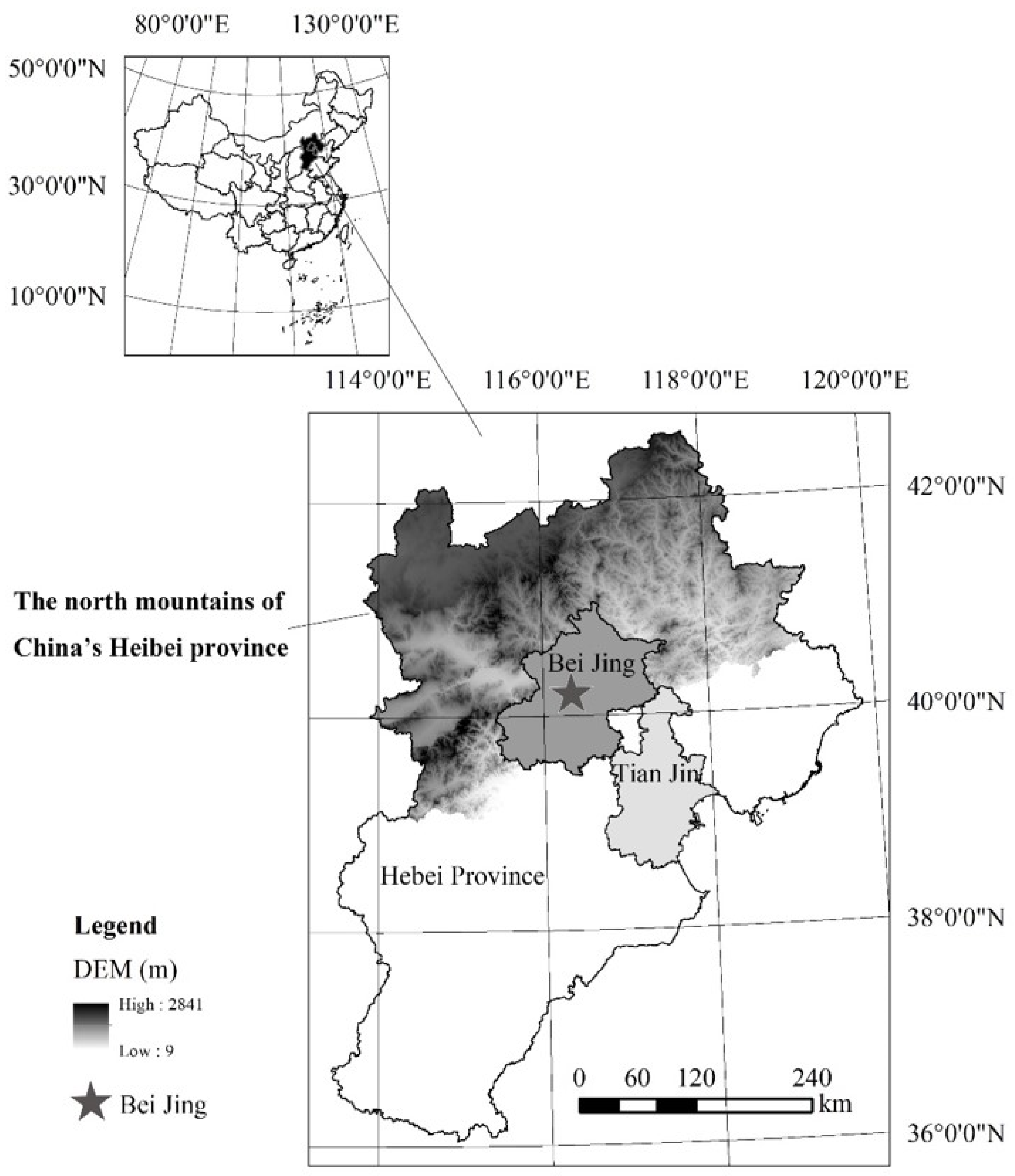

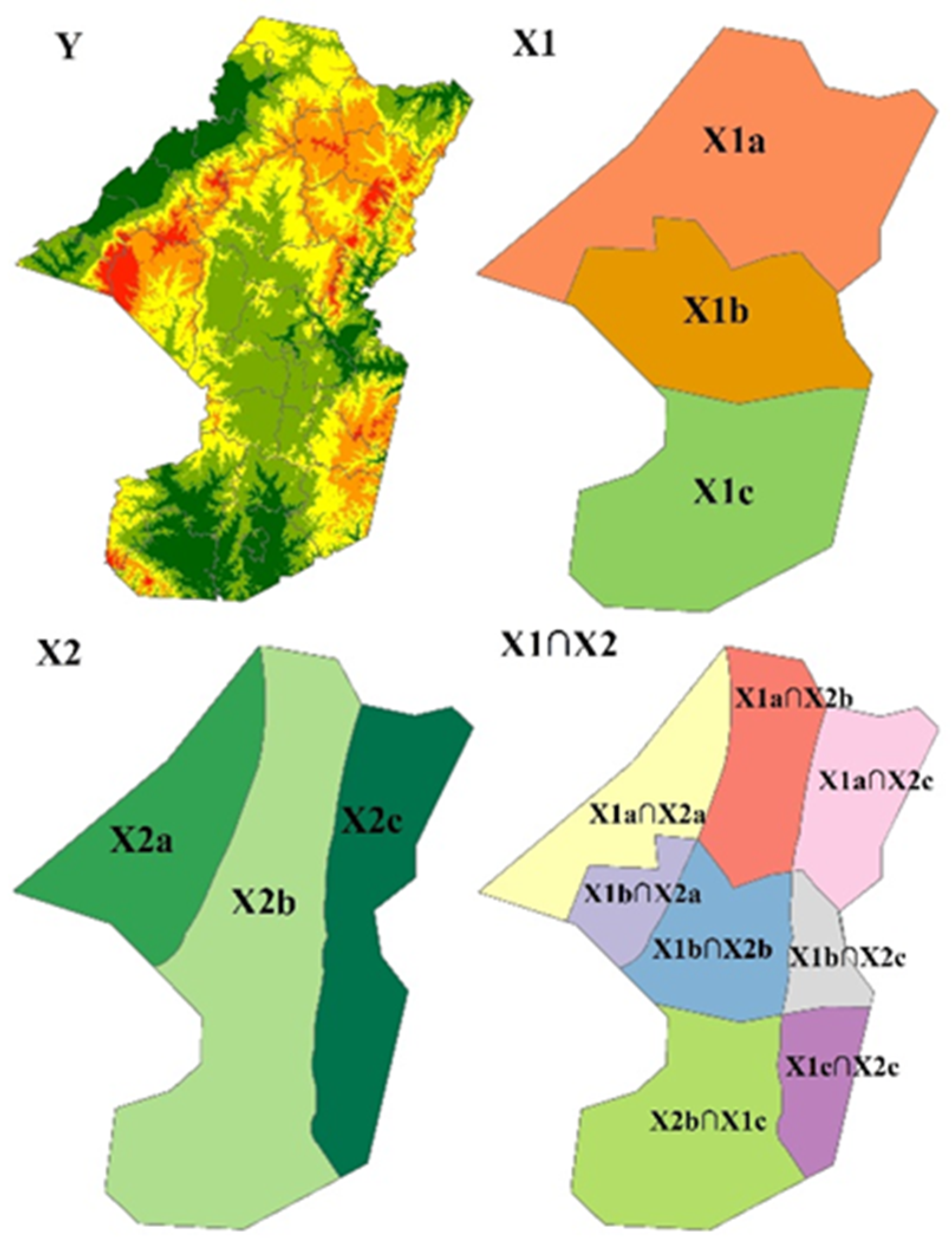
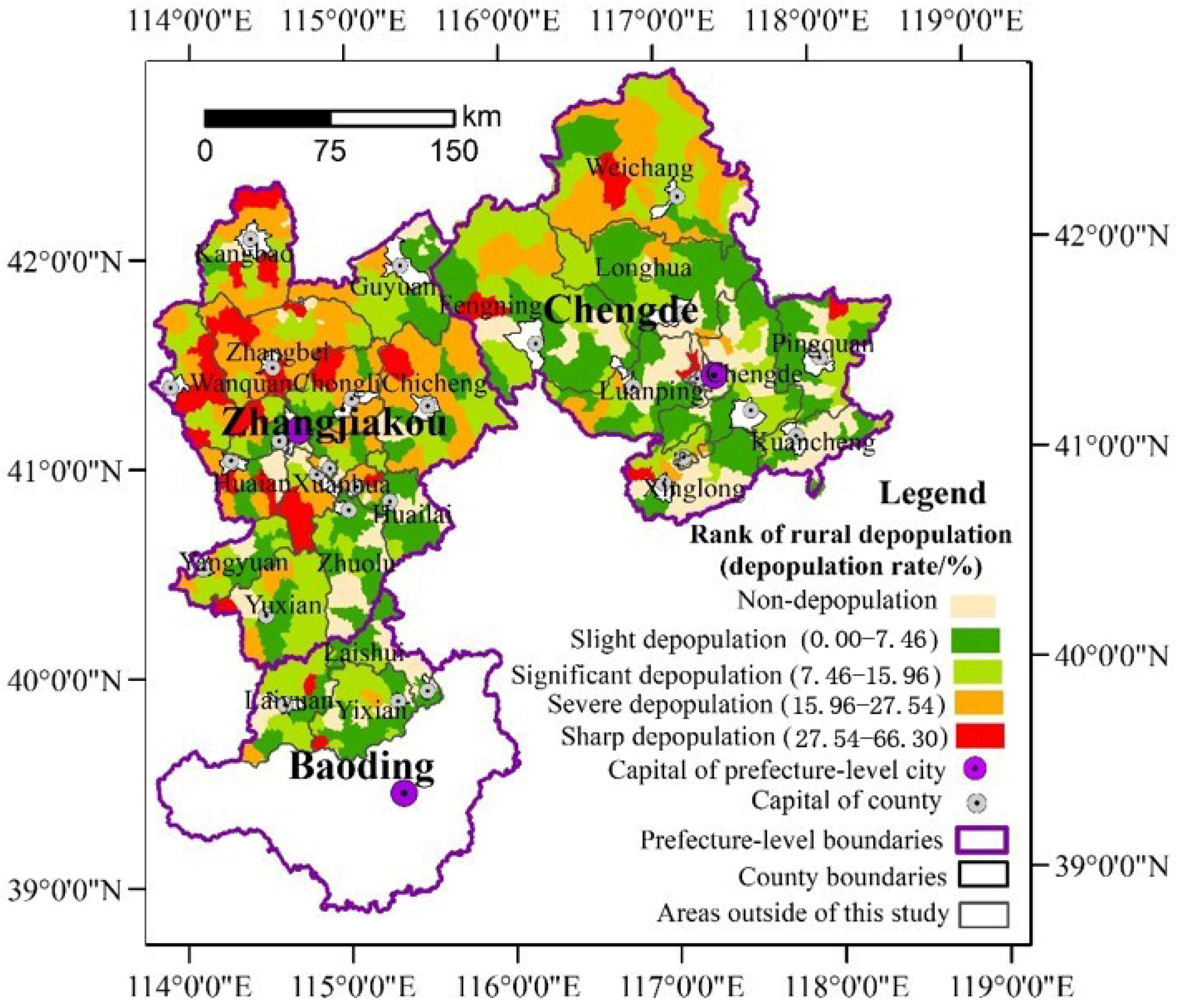
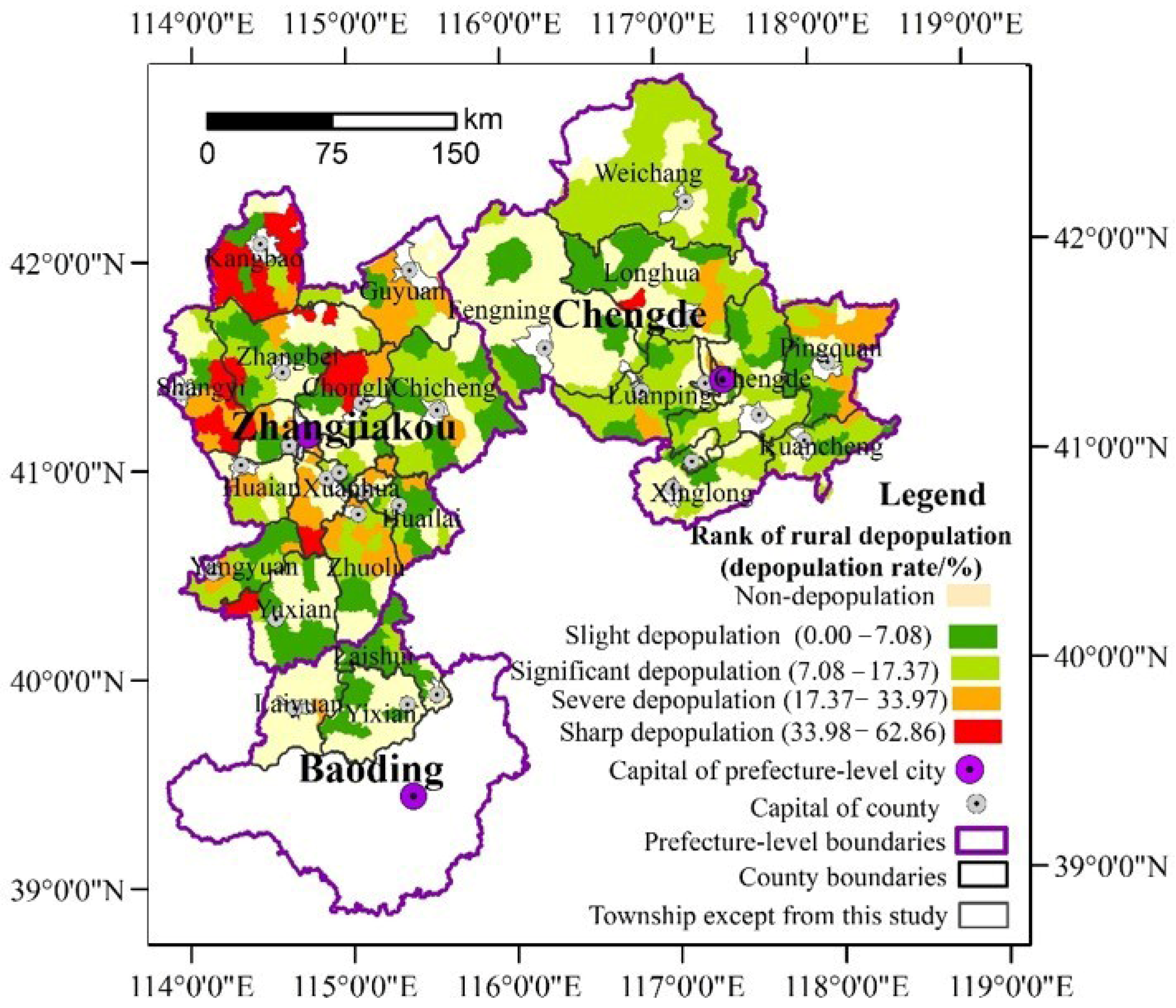
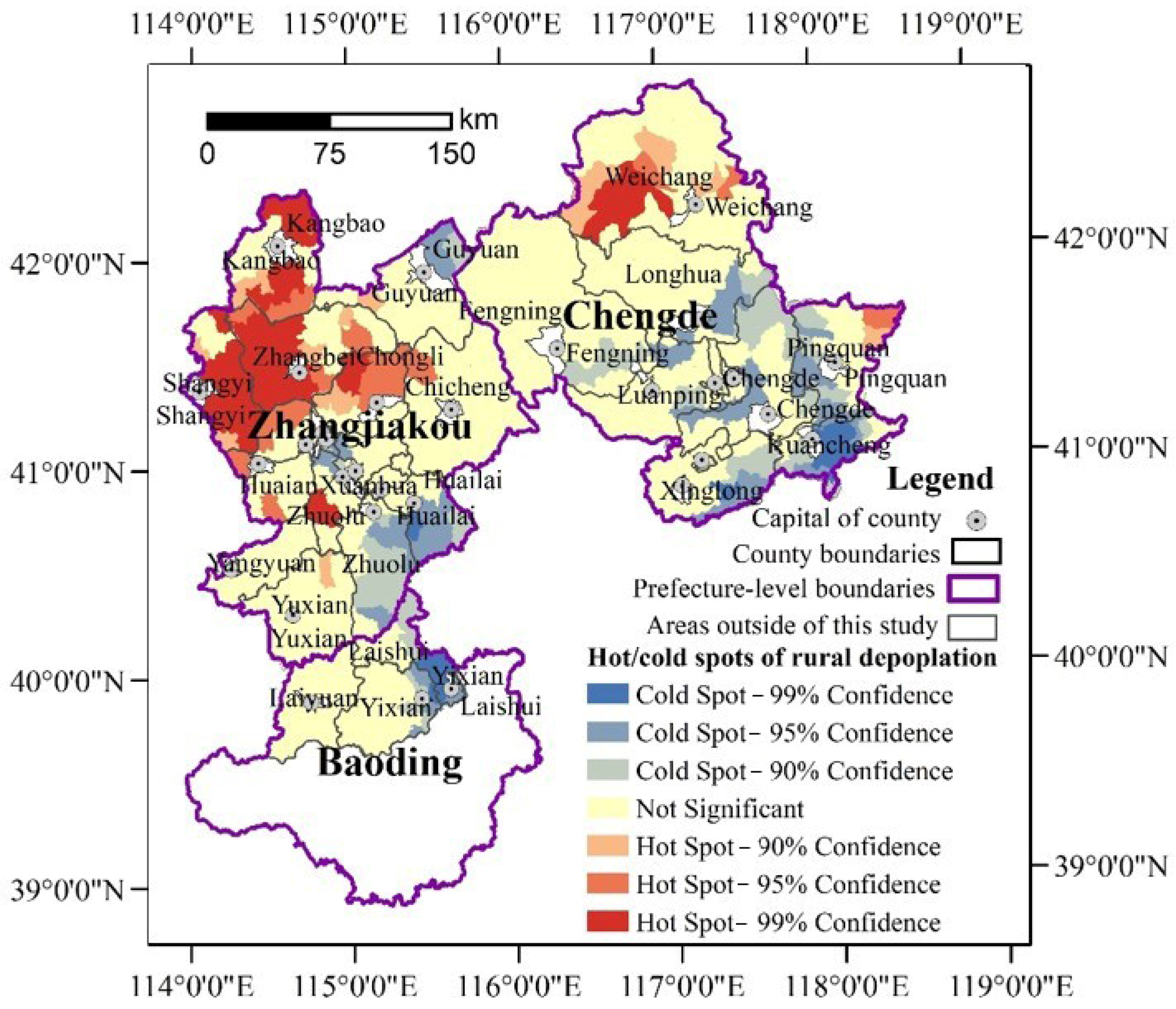
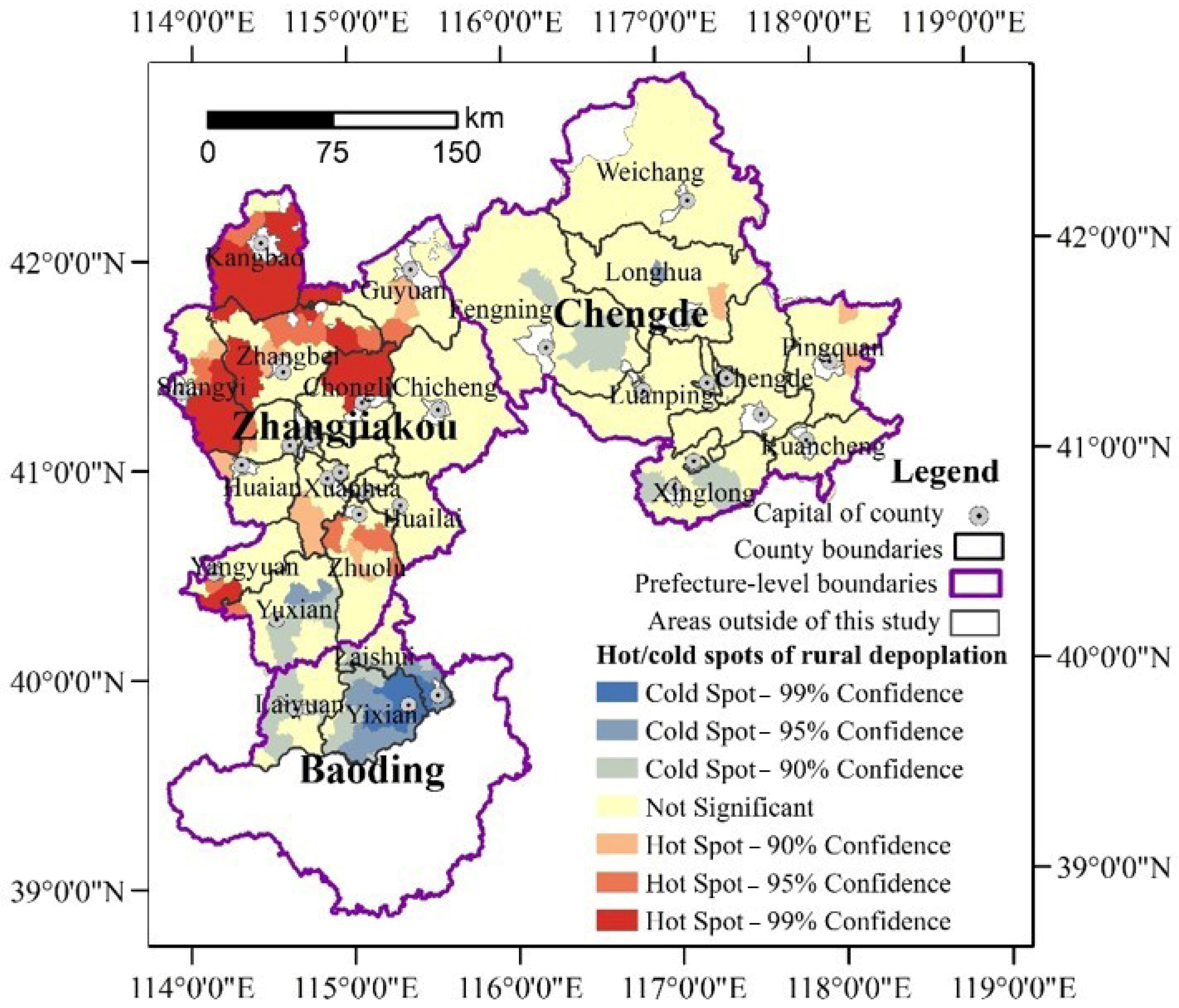

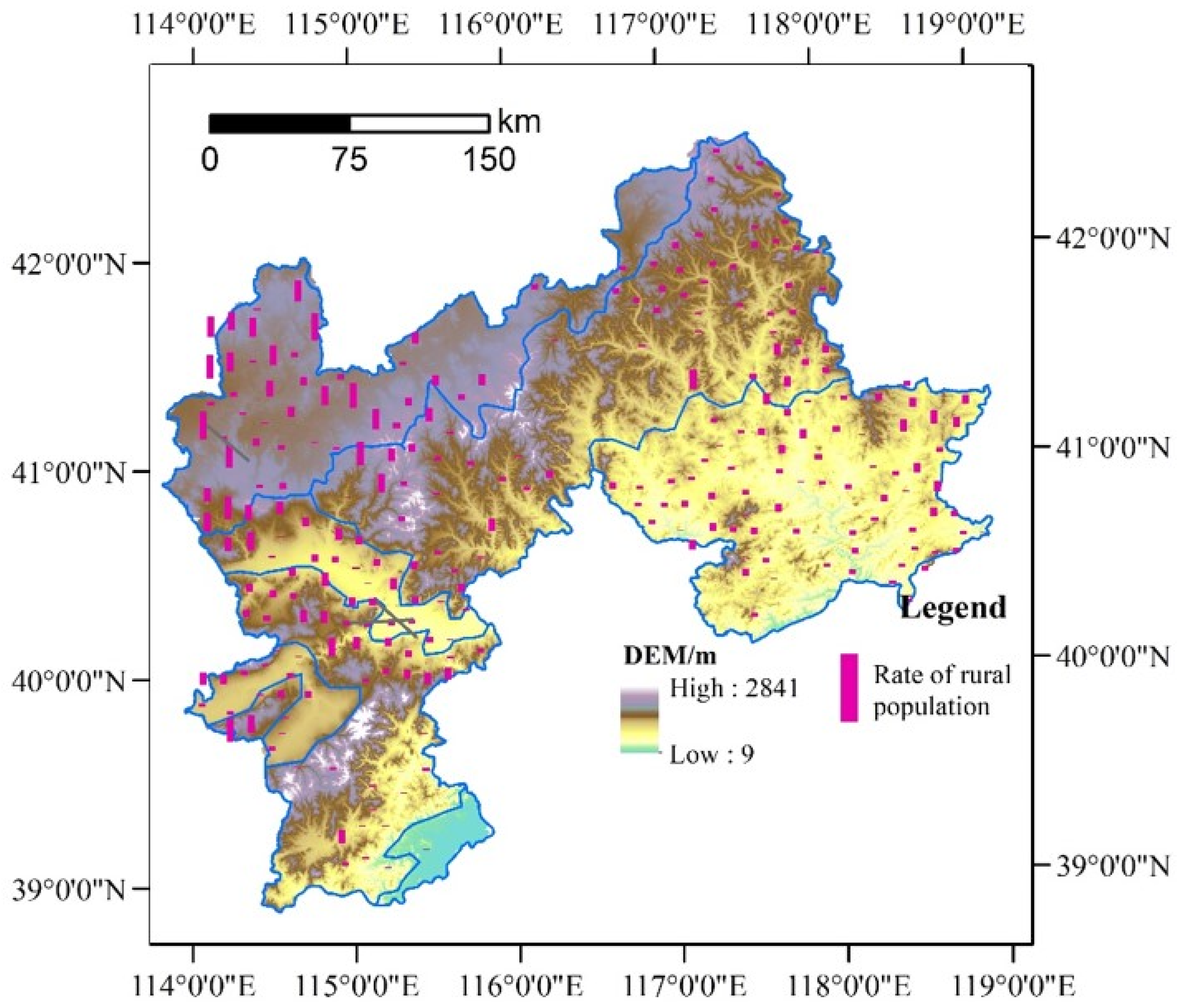
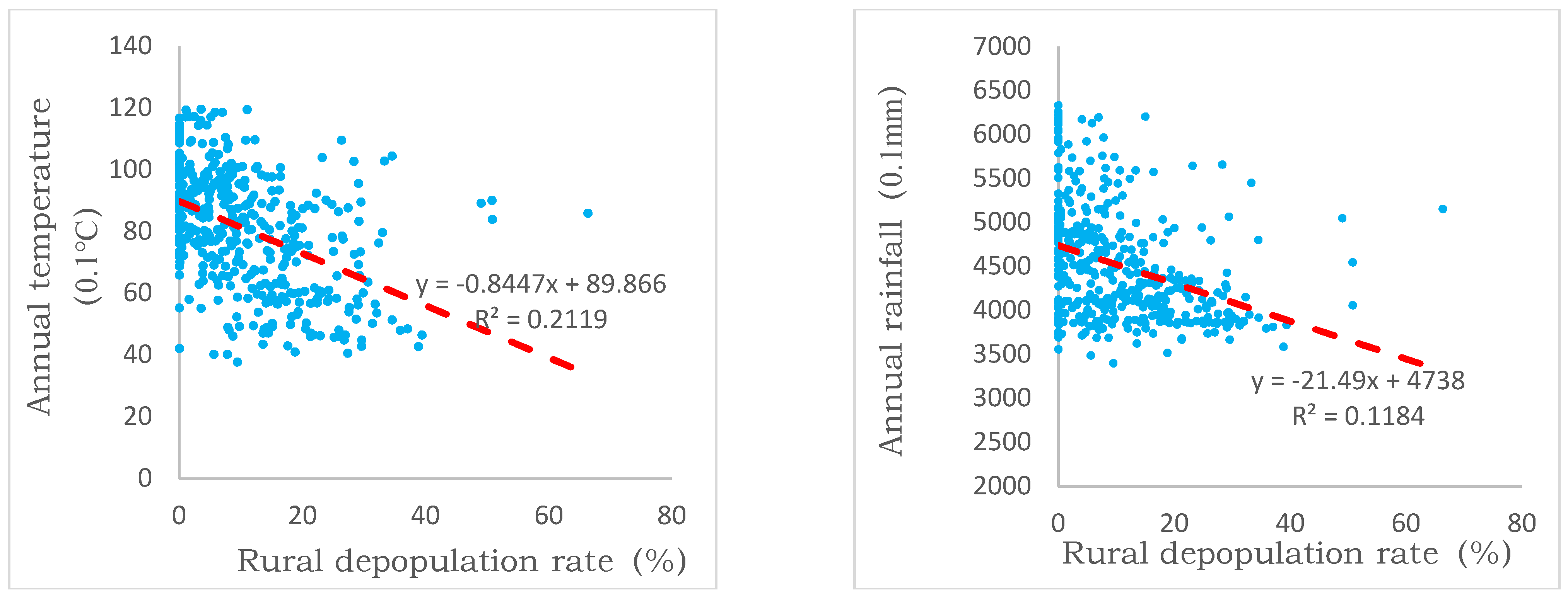


| Variables | Description of the Variables | Data Source |
|---|---|---|
| Natural environment | ||
| X1 Annual average rainfall | The average annual precipitation from 1980 to 2010 (mm). | The monthly data set of China’s monthly surface climatic data values on the National Meteorological Science Data Sharing Service Platform. The range of weather stations includes Mongolia, Shanxi, Hebei, Beijing, and Tianjin areas. |
| X2 Annual average temperature | The annual average temperature between 1980 and 2010 (0.1 °C). | |
| X3 Rainfall variability | The sum of the squares of deviations of the precipitation during the period ranging from 2000 to 2009, in which the annual average precipitation took the mean precipitation from 1980 to 2010 (mm2 × 104). | |
| X4 Terrain | It is denoted by the geomorphic types. The geomorphic types in the study area can be divided into five categories, including plains at middle or low altitudes, low-relief mountains, and hills at low altitudes; medium-relief mountains at middle altitudes, loess ridges, and hills at middle altitudes, hills, and high-relief mountains at medium or high altitudes. | The data were obtained from the Resource and Environmental Science Data Centre of the Chinese Academy of Sciences (Data Center of Resources and Environmental Sciences, Chinese Academy of Sciences; http://www.resdc.cn/ (accessed on 20 March 2017). |
| Rural economic opportunities | ||
| X5 Arable land per capita | It is calculated by dividing the total cultivated area by the total population. | Hebei Rural Statistical Yearbook |
| X6 Fertility of cultivated land | The average yield per unit area of cultivated land during the years ranging from 2000 to 2004 was adopted to estimate the land fertility (ton/hectare). | Hebei Rural Statistical Yearbook |
| X7 Agricultural economic density | The total output value of the agricultural, forestry, animal husbandry, and fishery in per unit administrative area (10,000 yuan/km2). | Hebei Rural Statistical Yearbook |
| X8 Off-farm economic opportunity | Total business income of rural township enterprises (10,000 yuan). | Hebei Rural Statistical Yearbook |
| X9 Rural residents’ income | The per capita net income of rural residents (yuan). | Same data source as the above |
| Location factors | ||
| X10 Distance to county-level capital | Based on road network data, the path distances (km) from the townships to prefectural capitals and county-level capitals were extracted by the cost-distance analysis tool in ArcGIS platform. | The vector road network data was provided by the local planning bureau. |
| X11 Distance to the prefectural capital | ||
| Social demographic factors | ||
| X12 Population density | Total population/administrative area (persons/square kilometer). | Township data set of 2000 Census |
| X13 Provision of public services | It can be represented by the townships’ fiscal revenue (10,000 yuan). | Hebei Rural Statistical Yearbook |
| Statistical Item | Min | Max | Mean | Standard Deviation | Number of Rural-Township |
|---|---|---|---|---|---|
| Population size of 2000 (person) | 1265 | 51,399 | 14,126 | 7880 | 442 |
| Population size of 2010 (person) | 1204 | 51,877 | 13,124 | 8082 | 442 |
| Population size of 2017 (person) | 1077 | 71,129 | 12,847 | 8874 | 442 |
| Size of population change (2000–2010) (person) | −17,519 | 26,080 | −1002 | 2338 | 442 |
| Size of population change (2010–2017) (person) | −8854 | 31,372 | −272 | 3122 | 442 |
| Rate of population change (2000–2010) (%) | −66.30 | 190.69 | −8.69 | 15.50 | 442 |
| Rate of population change (2010–2017) (%) | −62.86 | 230.76 | −3.06 | 24.05 | 442 |
| Size of rural depopulation (2000–2010) (person) | 11 | 17519 | 1571 | 1604 | 356 |
| Size of rural depopulation (2010–2017) (person) | 5 | 8854 | 1652 | 1593 | 277 |
| Rate of rural depopulation (2000–2010) (%) | 0.07 | 66.30 | 12.83 | 9.99 | 356 |
| Rate of rural depopulation (2010–2017) (%) | 0.03 | 62.86 | 14.39 | 12.71 | 277 |
| Explanatory Variables | 2000–2010 | 2010–2017 | |||
|---|---|---|---|---|---|
| q | Rank | q | Rank | ||
| Natural environmental factors | X1 Annual average rainfall | 0.1334 *** | 3 | 0.0185 | - |
| X2 Annual average temperature | 0.2143 *** | 1 | 0.1692 *** | 4 | |
| X3 Rainfall variability | 0.1143 *** | 5 | 0.0264 | - | |
| X4 Terrain | 0.0708 *** | 7 | 0.1009 *** | 10 | |
| Economic factors | X5 Arable land per capita | 0.2038 *** | 2 | 0.1041 *** | 9 |
| X6 Fertility of cultivated land | 0.0351 *** | 11 | 0.1363 *** | 5 | |
| X7 Agricultural economic density | 0.1219 *** | 4 | 0.2235 *** | 3 | |
| X8 Off-farm economic opportunity | 0.0663 *** | 8 | 0.2528 *** | 2 | |
| X9 Rural residents’ income | 0.0451 *** | 9 | 0.1206 *** | 8 | |
| Location factors | X10 Distance to county-level capital | 0.0068 | - | 0.1238 *** | 7 |
| X11 Distance to prefectural capital | 0.0266 ** | 12 | 0.1266 *** | 6 | |
| Social factors | X12 Population density | 0.0837 *** | 6 | 0.4427 *** | 1 |
| X13 Provision of public services | 0.0383 *** | 10 | 0.0967 ** | 11 | |
| Variables | X1 | X2 | X3 | X4 | X5 | X6 | X7 | X8 | X9 | X10 | X11 | X12 | X13 | |
|---|---|---|---|---|---|---|---|---|---|---|---|---|---|---|
| 2000–2010 | X1 Annual average rainfall | 13.34 | ||||||||||||
| X2 Annual average temperature | 27.31 | 21.40 | ||||||||||||
| X3 Rainfall variability | 16.29 | 26.08 | 11.43 | |||||||||||
| X4 Terrain | 18.71 | 25.72 | 20.05 | 7.08 | ||||||||||
| X5 Arable land per capita | 25.79 | 27.51 | 21.64 | 27.02 | 20.38 | |||||||||
| X6 Fertility of arable land | 17.77 | 24.26 | 14.31 | 10.86 | 23.23 | 3.51 | ||||||||
| X7 Agricultural economic density | 22.82 | 24.97 | 19.60 | 22.22 | 26.09 | 13.45 | 7.46 | |||||||
| X8 Off-farm economic opportunities | 27.01 | 27.95 | 25.12 | 18.19 | 25.94 | 14.63 | 14.51 | 6.63 | ||||||
| X9 Rural residents’ income | 23.56 | 26.09 | 21.12 | 18.27 | 24.61 | 10.53 | 12.92 | 10.97 | 4.51 | |||||
| X10 Distance to county-level capitals | 20.75 | 24.33 | 20.11 | 14.93 | 26.10 | 7.36 | 9.81 | 8.86 | 9.89 | 0.69 | ||||
| X11 Distance to prefectural capitals | 19.10 | 27.33 | 19.06 | 16.05 | 30.07 | 11.34 | 10.71 | 11.12 | 9.60 | 11.15 | 2.66 | |||
| X12 Population density | 26.24 | 25.12 | 24.70 | 21.14 | 27.80 | 17.18 | 12.61 | 12.28 | 12.84 | 10.09 | 10.55 | 8.37 | ||
| X13 Provision of public services | 22.88 | 24.15 | 19.52 | 14.26 | 25.32 | 13.12 | 11.80 | 9.49 | 8.95 | 6.15 | 9.55 | 12.58 | 3.83 | |
| 2010–2017 | X1 Annual average rainfall | 1.85 | ||||||||||||
| X2 Annual average temperature | 22.65 | 16.92 | ||||||||||||
| X3 Rainfall variability | 10.58 | 23.32 | 2.64 | |||||||||||
| X4 Terrain | 17.14 | 25.99 | 14.13 | 10.09 | ||||||||||
| X5 Arable land per capita | 17.42 | 19.99 | 16.82 | 25.77 | 10.41 | |||||||||
| X6 Fertility of cultivated land | 18.98 | 26.36 | 20 | 24.29 | 17.76 | 13.63 | ||||||||
| X7 Agricultural economic density | 29.81 | 33.13 | 24.44 | 25.27 | 30.98 | 29.43 | 22.35 | |||||||
| X8 Off-farm economic opportunity | 34.46 | 36.44 | 29.45 | 34.03 | 30.73 | 34.07 | 37.26 | 25.28 | ||||||
| X9 Rural residents’ income | 21.59 | 27.96 | 14.83 | 19.27 | 22.32 | 24 | 28.22 | 32.1 | 12.06 | |||||
| X10 Distance to county-level capital | 18.69 | 28.25 | 21.04 | 18.87 | 21.85 | 26.42 | 27.6 | 31.25 | 21.4 | 12.38 | ||||
| X11 Distance to prefectural capital | 20.01 | 25.75 | 17.19 | 21.62 | 24.09 | 24.5 | 29.42 | 35.12 | 22.42 | 21.97 | 12.66 | |||
| X12 Population density | 48.57 | 46.42 | 46.62 | 46.75 | 45.93 | 49.29 | 48.33 | 51.39 | 48.55 | 46.68 | 46.1 | 44.27 | ||
| X13 Provision of public services | 16.88 | 24.09 | 13.3 | 22.25 | 17.63 | 22.83 | 32.72 | 29.68 | 18.18 | 19.68 | 20.15 | 46.65 | 9.67 |
 From blue to red, the interaction detection coefficient increases gradually.
From blue to red, the interaction detection coefficient increases gradually.Publisher’s Note: MDPI stays neutral with regard to jurisdictional claims in published maps and institutional affiliations. |
© 2022 by the authors. Licensee MDPI, Basel, Switzerland. This article is an open access article distributed under the terms and conditions of the Creative Commons Attribution (CC BY) license (https://creativecommons.org/licenses/by/4.0/).
Share and Cite
Yu, Z.; Zhang, H.; Sun, P.; Guo, Y. The Pattern and Local Push Factors of Rural Depopulation in Less-Developed Areas: A Case Study in the Mountains of North Hebei Province, China. Int. J. Environ. Res. Public Health 2022, 19, 5909. https://doi.org/10.3390/ijerph19105909
Yu Z, Zhang H, Sun P, Guo Y. The Pattern and Local Push Factors of Rural Depopulation in Less-Developed Areas: A Case Study in the Mountains of North Hebei Province, China. International Journal of Environmental Research and Public Health. 2022; 19(10):5909. https://doi.org/10.3390/ijerph19105909
Chicago/Turabian StyleYu, Zhonglei, Hua Zhang, Piling Sun, and Yandi Guo. 2022. "The Pattern and Local Push Factors of Rural Depopulation in Less-Developed Areas: A Case Study in the Mountains of North Hebei Province, China" International Journal of Environmental Research and Public Health 19, no. 10: 5909. https://doi.org/10.3390/ijerph19105909






